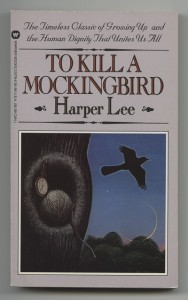By: Page Novak, UA undergraduate
This fall, step into the lobby of Mary Harmon Bryant Hall to see Page Novak’s display of banned books celebrating Banned Book Week, which was September 21-27. Novak’s exhibition will be up for the remainder of the semester.
In case you can’t manage to stop by, you can read more about the books she selected to feature here. On Monday, she discussed Ulysses and 1984; today, she shares information about Beloved and To Kill a Mockingbird.
Beloved
The novel Beloved (1978) by Toni Morrison follows a slave named Sethe who escapes to Ohio from a plantation in Kentucky owned by Mr. Garner to find her family and free herself. Throughout the novel, flashbacks portray what Sethe’s life was like in Kentucky as well as when she first came to Cincinnati. Sethe was free when she first arrived, but a school teacher from the plantation came to find her and her children. Before the school teacher could get to Sethe’s children, she took them to a shed to kill them, but only succeeded in killing her youngest daughter who became the ghost that haunts Sethe’s house on 124 Bluestone Road.
Many school districts throughout the United States challenged the inclusion of the novel Beloved on their curriculum. In 2011, parents of AP English students brought up the racial slurs and sexuality present throughout the novel. These charges made Beloved one of the most challenged books in the United States since it was published.
To Kill a Mockingbird
To Kill a Mockingbird (1960) by Harper Lee received rave reviews in The New Yorker and Time magazines. In the story, Scout and Jem, her brother, live with their widowed father Atticus, who is a prosperous and well-known lawyer. The summer before Scout starts school, the siblings and their close friend Dill become interested in a creepy house down the street known as Radley place. This house is where Boo, a recluse who has never been seen by anyone, supposedly lives. The three adolescents spend their childhood trying to see if Arthur “Boo” Radley is really there or if he is just a tale. Throughout the course of the novel, Boo protects the children, often without being detected.
When the novel To Kill a Mockingbird first entered the classroom in 1963, the topic of rape and racial inequality in the American South became a reoccurring issue for parents and school administrators to consider. “Racial slurs, profanity, and blunt dialogue about rape” are the reasons that this novel is frequently challenged in school districts. Many parents were so outraged that the subject of rape was in the novel that they sent letters to the local newspaper to help the get the book banned from school curricula. Some school districts throughout the United States eventually decided to ban the novel from their school systems because of the language that is present throughout the book and the fact that the novel did not present a portrait of a positive and seamless integration process in the South.


